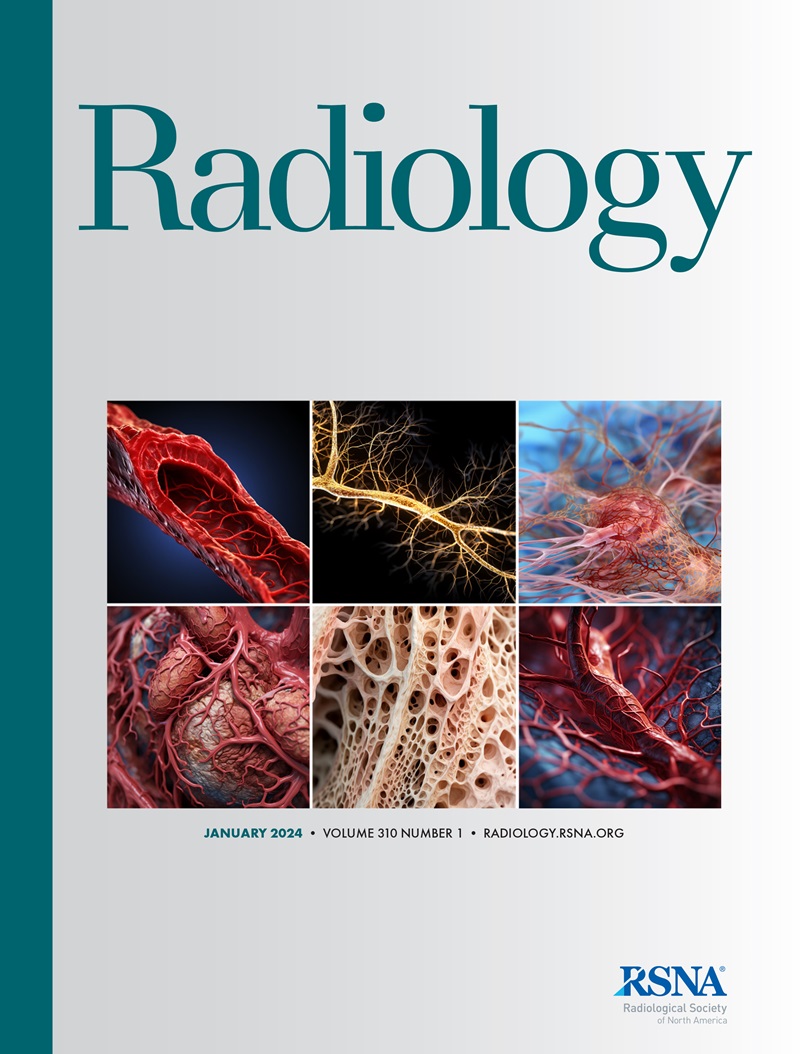Fully Automated Deep Learning Model to Detect Clinically Significant Prostate Cancer at MRI.
Jason C Cai, Hirotsugu Nakai, Shiba Kuanar, Adam T Froemming, Candice W Bolan, Akira Kawashima, Hiroaki Takahashi, Lance A Mynderse, Chandler D Dora, Mitchell R Humphreys, Panagiotis Korfiatis, Pouria Rouzrokh, Alexander K Bratt, Gian Marco Conte, Bradley J Erickson, Naoki Takahashi
下载PDF
{"title":"Fully Automated Deep Learning Model to Detect Clinically Significant Prostate Cancer at MRI.","authors":"Jason C Cai, Hirotsugu Nakai, Shiba Kuanar, Adam T Froemming, Candice W Bolan, Akira Kawashima, Hiroaki Takahashi, Lance A Mynderse, Chandler D Dora, Mitchell R Humphreys, Panagiotis Korfiatis, Pouria Rouzrokh, Alexander K Bratt, Gian Marco Conte, Bradley J Erickson, Naoki Takahashi","doi":"10.1148/radiol.232635","DOIUrl":null,"url":null,"abstract":"<p><p>Background Multiparametric MRI can help identify clinically significant prostate cancer (csPCa) (Gleason score ≥7) but is limited by reader experience and interobserver variability. In contrast, deep learning (DL) produces deterministic outputs. Purpose To develop a DL model to predict the presence of csPCa by using patient-level labels without information about tumor location and to compare its performance with that of radiologists. Materials and Methods Data from patients without known csPCa who underwent MRI from January 2017 to December 2019 at one of multiple sites of a single academic institution were retrospectively reviewed. A convolutional neural network was trained to predict csPCa from T2-weighted images, diffusion-weighted images, apparent diffusion coefficient maps, and T1-weighted contrast-enhanced images. The reference standard was pathologic diagnosis. Radiologist performance was evaluated as follows: Radiology reports were used for the internal test set, and four radiologists' PI-RADS ratings were used for the external (ProstateX) test set. The performance was compared using areas under the receiver operating characteristic curves (AUCs) and the DeLong test. Gradient-weighted class activation maps (Grad-CAMs) were used to show tumor localization. Results Among 5735 examinations in 5215 patients (mean age, 66 years ± 8 [SD]; all male), 1514 examinations (1454 patients) showed csPCa. In the internal test set (400 examinations), the AUC was 0.89 and 0.89 for the DL classifier and radiologists, respectively (<i>P</i> = .88). In the external test set (204 examinations), the AUC was 0.86 and 0.84 for the DL classifier and radiologists, respectively (<i>P</i> = .68). DL classifier plus radiologists had an AUC of 0.89 (<i>P</i> < .001). Grad-CAMs demonstrated activation over the csPCa lesion in 35 of 38 and 56 of 58 true-positive examinations in internal and external test sets, respectively. Conclusion The performance of a DL model was not different from that of radiologists in the detection of csPCa at MRI, and Grad-CAMs localized the tumor. © RSNA, 2024 <i>Supplemental material is available for this article.</i> See also the editorial by Johnson and Chandarana in this issue.</p>","PeriodicalId":20896,"journal":{"name":"Radiology","volume":null,"pages":null},"PeriodicalIF":12.1000,"publicationDate":"2024-08-01","publicationTypes":"Journal Article","fieldsOfStudy":null,"isOpenAccess":false,"openAccessPdf":"https://www.ncbi.nlm.nih.gov/pmc/articles/PMC11366675/pdf/","citationCount":"0","resultStr":null,"platform":"Semanticscholar","paperid":null,"PeriodicalName":"Radiology","FirstCategoryId":"3","ListUrlMain":"https://doi.org/10.1148/radiol.232635","RegionNum":1,"RegionCategory":"医学","ArticlePicture":[],"TitleCN":null,"AbstractTextCN":null,"PMCID":null,"EPubDate":"","PubModel":"","JCR":"Q1","JCRName":"RADIOLOGY, NUCLEAR MEDICINE & MEDICAL IMAGING","Score":null,"Total":0}
引用次数: 0
引用
批量引用
Abstract
Background Multiparametric MRI can help identify clinically significant prostate cancer (csPCa) (Gleason score ≥7) but is limited by reader experience and interobserver variability. In contrast, deep learning (DL) produces deterministic outputs. Purpose To develop a DL model to predict the presence of csPCa by using patient-level labels without information about tumor location and to compare its performance with that of radiologists. Materials and Methods Data from patients without known csPCa who underwent MRI from January 2017 to December 2019 at one of multiple sites of a single academic institution were retrospectively reviewed. A convolutional neural network was trained to predict csPCa from T2-weighted images, diffusion-weighted images, apparent diffusion coefficient maps, and T1-weighted contrast-enhanced images. The reference standard was pathologic diagnosis. Radiologist performance was evaluated as follows: Radiology reports were used for the internal test set, and four radiologists' PI-RADS ratings were used for the external (ProstateX) test set. The performance was compared using areas under the receiver operating characteristic curves (AUCs) and the DeLong test. Gradient-weighted class activation maps (Grad-CAMs) were used to show tumor localization. Results Among 5735 examinations in 5215 patients (mean age, 66 years ± 8 [SD]; all male), 1514 examinations (1454 patients) showed csPCa. In the internal test set (400 examinations), the AUC was 0.89 and 0.89 for the DL classifier and radiologists, respectively (P = .88). In the external test set (204 examinations), the AUC was 0.86 and 0.84 for the DL classifier and radiologists, respectively (P = .68). DL classifier plus radiologists had an AUC of 0.89 (P < .001). Grad-CAMs demonstrated activation over the csPCa lesion in 35 of 38 and 56 of 58 true-positive examinations in internal and external test sets, respectively. Conclusion The performance of a DL model was not different from that of radiologists in the detection of csPCa at MRI, and Grad-CAMs localized the tumor. © RSNA, 2024 Supplemental material is available for this article. See also the editorial by Johnson and Chandarana in this issue.
全自动深度学习模型在核磁共振成像中检测具有临床意义的前列腺癌。
背景 多参数磁共振成像有助于识别有临床意义的前列腺癌(csPCa)(格里森评分≥7 分),但受限于读者经验和观察者之间的差异。相比之下,深度学习(DL)能产生确定性输出。目的 开发一种深度学习模型,通过使用患者级别的标签预测 csPCa 的存在,但不包含肿瘤位置信息,并将其性能与放射科医生的性能进行比较。材料和方法 回顾性审查了 2017 年 1 月至 2019 年 12 月期间在一家学术机构的多个地点之一接受磁共振成像检查的无已知 csPCa 患者的数据。通过训练卷积神经网络,从 T2 加权图像、弥散加权图像、表观弥散系数图和 T1 加权对比增强图像预测 csPCa。参考标准是病理诊断。放射科医生的工作表现评估如下:内部测试集使用放射科报告,外部(ProstateX)测试集使用四位放射科医生的 PI-RADS 评级。使用接收器操作特征曲线下面积(AUC)和 DeLong 检验对性能进行比较。梯度加权类激活图(Grad-CAM)用于显示肿瘤定位。结果 在对 5215 名患者(平均年龄为 66 岁 ± 8 [SD];均为男性)进行的 5735 次检查中,有 1514 次检查(1454 名患者)发现了 csPCa。在内部测试集(400 次检查)中,DL 分类器和放射科医生的 AUC 分别为 0.89 和 0.89(P = 0.88)。在外部测试集(204 次检查)中,DL 分类器和放射科医生的 AUC 分别为 0.86 和 0.84(P = .68)。DL 分类器加上放射科医生的 AUC 为 0.89(P < .001)。在内部和外部测试集中,Grad-CAM 分别在 38 次和 58 次真阳性检查中的 35 次和 56 次中显示出 csPCa 病灶的激活。结论 DL 模型在核磁共振成像中检测 csPCa 的性能与放射科医生无异,Grad-CAM 可定位肿瘤。RSNA, 2024 这篇文章有补充材料。另请参阅本期 Johnson 和 Chandarana 的社论。
本文章由计算机程序翻译,如有差异,请以英文原文为准。


